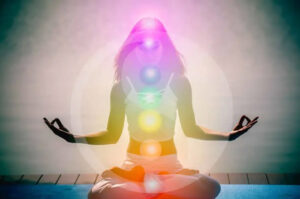Get your FREE Chakra Balancing Assessment done today Click Here
Chakra balancing is a concept rooted in various spiritual traditions, particularly within the practices of yoga, meditation, and Ayurveda. The term “chakra” comes from the Sanskrit word meaning “wheel” or “disk,” and in the context of spiritual practice, it refers to centers of energy within the human body.
The Seven Major Chakras:
- Root Chakra (Muladhara):
- Location: Base of the spine
- Color: Red
- Associated with: Grounding, survival, stability, and security.
- Sacral Chakra (Svadhisthana):
- Location: Lower abdomen, about two inches below the navel
- Color: Orange
- Associated with: Creativity, pleasure, sexuality, and emotions.
- Solar Plexus Chakra (Manipura):
- Location: Upper abdomen, near the stomach
- Color: Yellow
- Associated with: Personal power, self-esteem, and confidence.
- Heart Chakra (Anahata):
- Location: Center of the chest
- Color: Green
- Associated with: Love, compassion, and emotional balance.
- Throat Chakra (Vishuddha):
- Location: Throat
- Color: Blue
- Associated with: Communication, self-expression, and truth.
- Third Eye Chakra (Ajna):
- Location: Forehead, between the eyes
- Color: Indigo
- Associated with: Intuition, wisdom, and insight.
- Crown Chakra (Sahasrara):
- Location: Top of the head
- Color: Violet or white
- Associated with: Spiritual connection, enlightenment, and higher consciousness.
Chakra Balancing: Watch this free video
The idea of chakra balancing involves ensuring that each of these energy centers is open, flowing, and aligned with the others. Imbalances can manifest as physical, emotional, or spiritual issues. For example, if the heart chakra is blocked, a person might struggle with feelings of loneliness or an inability to give or receive love
Techniques for Balancing Chakras: Click Here To BUY COURSE
- Meditation: Specific meditations can focus on individual chakras, often using visualizations or mantras that correspond to each chakra.
- Yoga: Many yoga poses are designed to stimulate and open specific chakras. For example, backbends can help open the heart chakra.
- Reiki and Energy Healing: Practitioners use their hands to channel energy into the chakras to help remove blockages and restore balance.
- Sound Healing: Each chakra is thought to respond to specific frequencies or sounds. Singing bowls, tuning forks, or chanting can be used to align chakras.
- Crystals: Certain crystals are believed to resonate with specific chakras. For instance, amethyst is associated with the third eye chakra, while rose quartz is linked to the heart chakra.
- Aromatherapy: Essential oils like lavender, sandalwood, or frankincense can be used to enhance meditation or healing practices and help balance the chakras.
Signs of Imbalanced Chakras:
- Root Chakra: Feeling ungrounded, anxious, or insecure.
- Sacral Chakra: Difficulty with creativity, sexual dysfunction, or emotional instability.
- Solar Plexus Chakra: Low self-esteem, lack of control, or feelings of powerlessness.
- Heart Chakra: Trouble forming connections, feeling isolated, or experiencing grief.
- Throat Chakra: Difficulty expressing oneself, throat issues, or shyness.
- Third Eye Chakra: Lack of intuition, difficulty focusing, or feeling disconnected from reality.
- Crown Chakra: Spiritual disconnection, depression, or lack of purpose.
Balancing your chakras can lead to a sense of well-being, inner peace, and improved physical and emotional health
